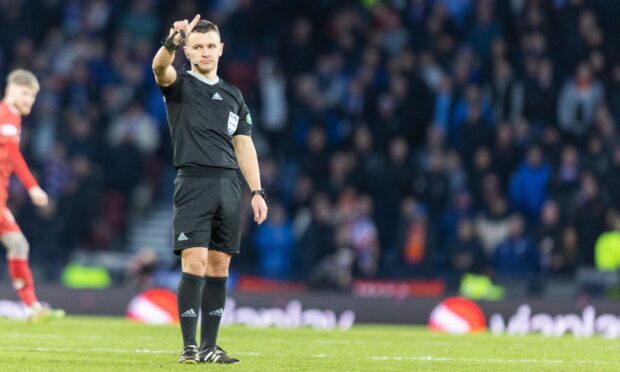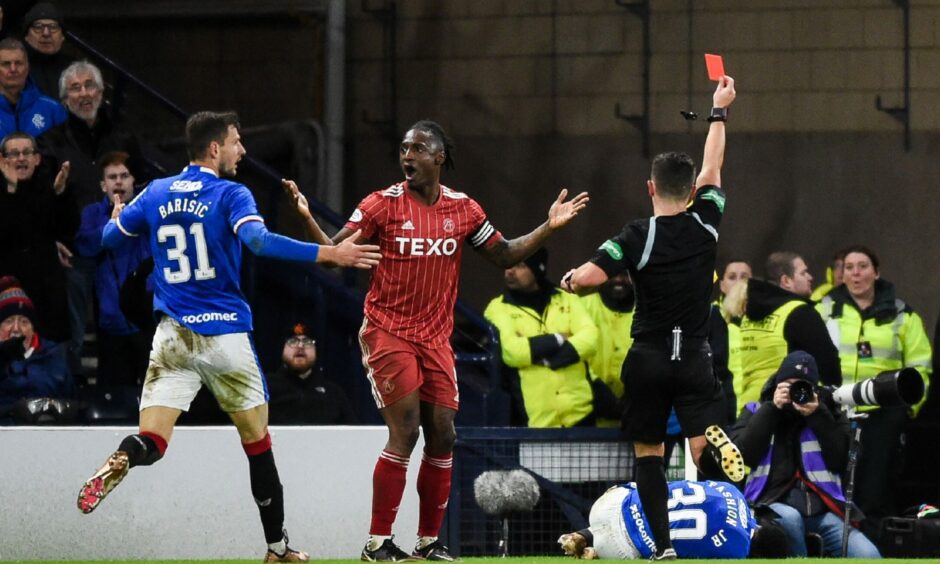Aberdeen v Rangers games are always contentious affairs – and Sunday’s Hampden League Cup semi-final, which the Dons lost 2-1 after extra-time, was no different.
Here, we take a look at the big talking points from a refereeing/officiating standpoint, assess whether the calls were correct, how they were influenced by technology, and try to clear up just why Rangers’ Ryan Kent went unpunished for appearing to strike Aberdeen’s Liam Scales off the ball at the end of the regulation 90 minutes.
Miovski allowed to score before offside flag raised due to VAR protocols
Although Gers forward Alfredo Morelos tried in vain to claim an early effort had crossed the line at the National Stadium (something easily ruled out by Walsh and his team, and backed up by black-and-white goal-line technology), the first real officiating talking point was the opener from Aberdeen’s Bojan Miovski which never stood…
The Dons thought they had taken the lead on 16 minutes in the semi-final.
Miovski raced on to a through-ball and towards goal, and with Rangers’ defence having stopped, excellently fired the ball past Allan McGregor from a tight angle.
The offside flag was raised after the play had been completed, which meant bedlam in the Aberdeen end quickly changed to disappointment.
At the time, I did think Miovski had just slightly mistimed his run, but, after seeing the replays after the game, I realised just how tight of a call it was.
It was an excellent in-game call from the linesman. While it is obviously disappointing the flag isn’t raised until after the goal is scored, this is the new protocol with VAR, which is also important for double-checking calls like these where the margins are so fine.
Aberdeen striker’s rules intelligence in build-up to eventual opener
Aberdeen would score for real on 41 minutes, when Matty Kennedy caught the Rangers defence sleeping with a deep run from an onside position.
The initial ball was meant for team-mate Miovski, who was again in an offside position, but he smartly left it – which seemed to make the Gers players forget play hadn’t been stopped.
The decision by ref Walsh and his team not to award an offside in this moment was spot on, as Miovski made no attempt to play the ball or interfere with play.
This allowed Kennedy to get the ball and deliver a fantastic cross which a then-onside Miovski finished.
Miovski fires @AberdeenFC in front against Rangers! 😱
It's bedlam in the Hampden stands as the Aberdeen fans go wild! 🔴🙌#RANABE | #ViaplayCup | @spfl pic.twitter.com/q6qf8KYJ32
— Viaplay Sports UK (@ViaplaySportsUK) January 15, 2023
As a linesperson, you are always told to wait and see when a ball is played forward – this was showcased perfectly here.
If Walsh hadn’t shown Stewart immediate red – VAR likely would have made him change his mind
With the score at 1-1, the cup semi would change drastically just before the 90 minutes was up, when Aberdeen captain Anthony Stewart dived into a touchline challenge with Rangers forward Fashion Sakala.
With the player going nowhere, as soon as you fly into a challenge at that speed, you are asking the question of the referee to show a red card.
As Dons manager Jim Goodwin said in his post-match interview, there can be “no arguments” about the sending off – Walsh was right to award a red and, if he hadn’t, surely VAR would have asked him to look again.
Was VAR working during Ryan Kent-Liam Scales clash?
However, there is a question about when VAR was actually operational at Hampden on Sunday – and, crucially, when it wasn’t.
At the start of extra time, after a confusing delay, the tannoy announced due to connection issues VAR wouldn’t be available for the rest of the match, before it was later announced it was working again. It was a pretty shambolic state of affairs, and one TV viewers were made aware of by the Viaplay commentary team before those in the ground were.
As well as the ongoing problem of how fans in the stadium are kept in the loop with VAR, the system’s apparent breakdown raises a question of consistency – what if a penalty or red card for one team was missed while VAR was out of play at the start of extra-time, but then a few a minutes later – once it was working again – a VAR check saw a penalty of red card awarded to the other team following a similar incident? It would have been a big controversy.
Overall, I thought Walsh let a lot go in what was a spirited game, and on another day there could have been far more cautions.
As I’ve said, VAR wasn’t really needed for the Stewart incident the way it played out, but was it working and able to check the off-the-ball incident involving Ryan Kent and Liam Scales which also came in added time at the end of the 90 minutes?
RED CARD every day of the week and twice on Sunday's but VAR didn't refer Nick Walsh to the monitor… why? https://t.co/qPy9bFaMcb
— Inside The SPFL (@AgentScotland) January 15, 2023
I say this because the “punch” (as many Aberdeen supporters have deemed it) from Rangers attacker Kent on Scales looked like it was, at minimum, a yellow card – therefore, if VAR was operational, why wasn’t Walsh sent to the monitor to decide whether or not it was a red?
- Finlay Elder has been a registered referee for six years and a category 5 official since 2019, with experience in the Highland League, juniors and Club Academy.




Conversation